I’m a romantic who just likes old-fashioned stuff that was built to last. That’s why I love old roses so much. Many of them have a huge flush of flowers once or twice a year – but they more than make up for this in ruggedness, beauty, and delicious fragrance.
But there’s another benefit for growing old roses. Many antique roses, as well as species roses, will bear hips in the fall and through the rest of the year.
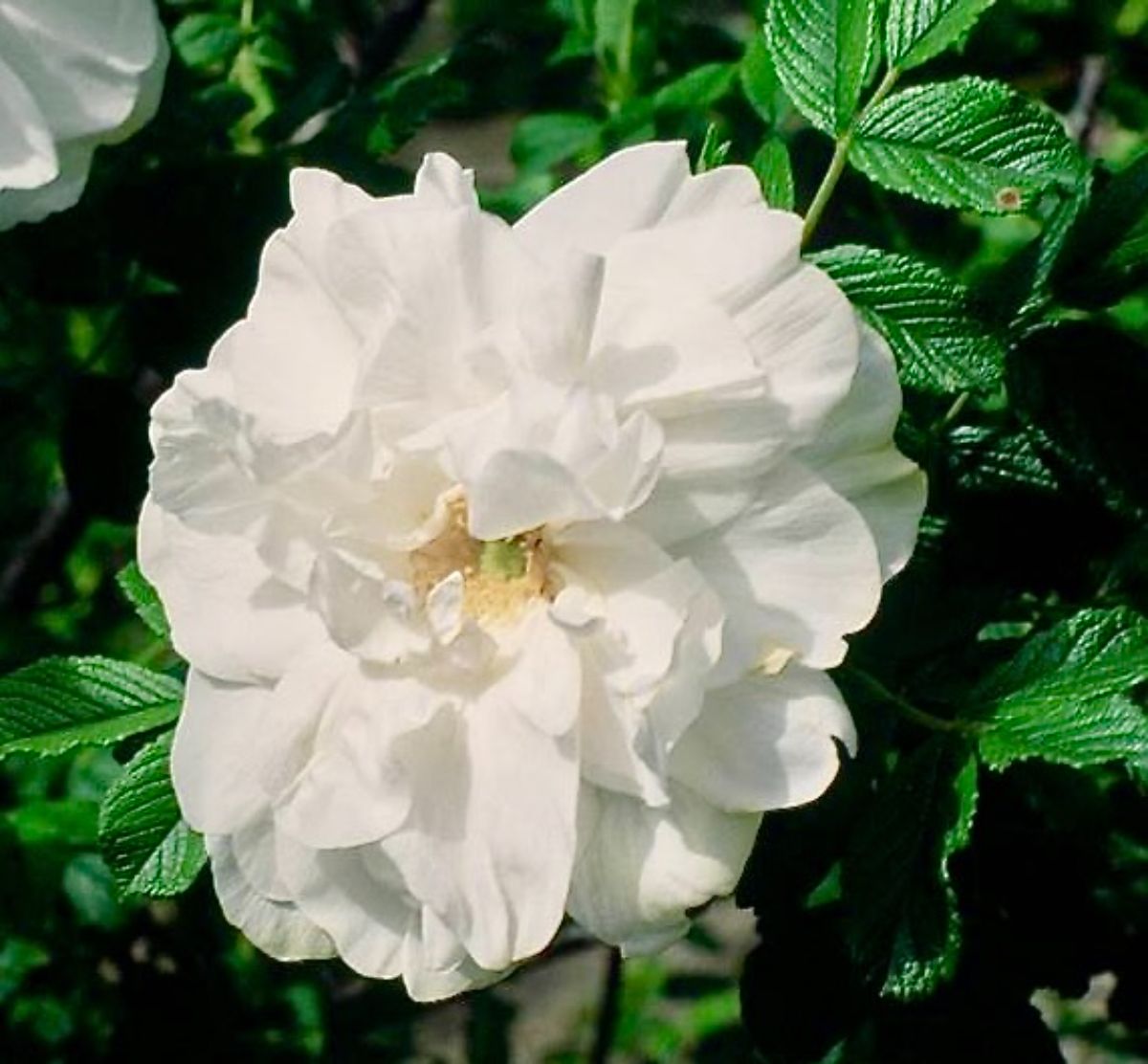
If you’re a real rose fiend who grows a lot of old roses at home and don’t spray them with chemicals, you can harvest the hips off them. The rest of us get to go traipsing into forests and fields and beaches to forage!
Fall is rose hip season, and the cool weather makes it a great time for wildcrafters to forage for rose hips.
Jump to:
What Are Rose Hips?
If you already grow old heirloom roses or live in an area with a lot of wild roses, then you’ve probably already seen rose hips. After the rose blossom falls apart, what remains is something that looks like a green berry, which later turns orange or red. This is the ovary of the rose – technically a fruit, not a berry – that contains rose seeds.
Rose hips are beautiful in the fall. Though generally, hips are red, yellow, or orange, a few can be yellow-green, while the hips of Rosa pimpinellifolia are dark purple to almost black. Hips will stay on the shrub all winter unless they’re eaten by birds.
Which Roses Have Rose Hips?

You’ll commonly see rose hips on old antique roses, shrub roses, and species roses. Hips are less common on modern roses, such as Knock Out roses. Many newer roses are bred to be “self-cleaning” – that is, the flower shoot will fall off after it’s finished blooming.
Here are a few of the many wild species of roses you might see hips on:

Rugosa roses (Rosa rugosa) – These are also known as beach rose or saltspray rose (because they often grow on sand dunes), or beach tomato because their large red hips look like small tomatoes. Rugosas are big shrub roses with tidy, wrinkly leaves and wonderfully fragrant flowers.
Rugosa roses are rugged and tough, growing in harsh conditions with bitter cold, poor soil, and salt spray. They don’t need much to survive. I once saw a rugosa rose blooming in a crack on the side of a concrete lock and dam in St. Paul, Minnesota.
A native of Japan, China, and Korea, these roses have become invasive in New England in the United States and the Maritimes in Canada.
These roses are plentiful on the beach, naturally yielding bucketfuls of hips.
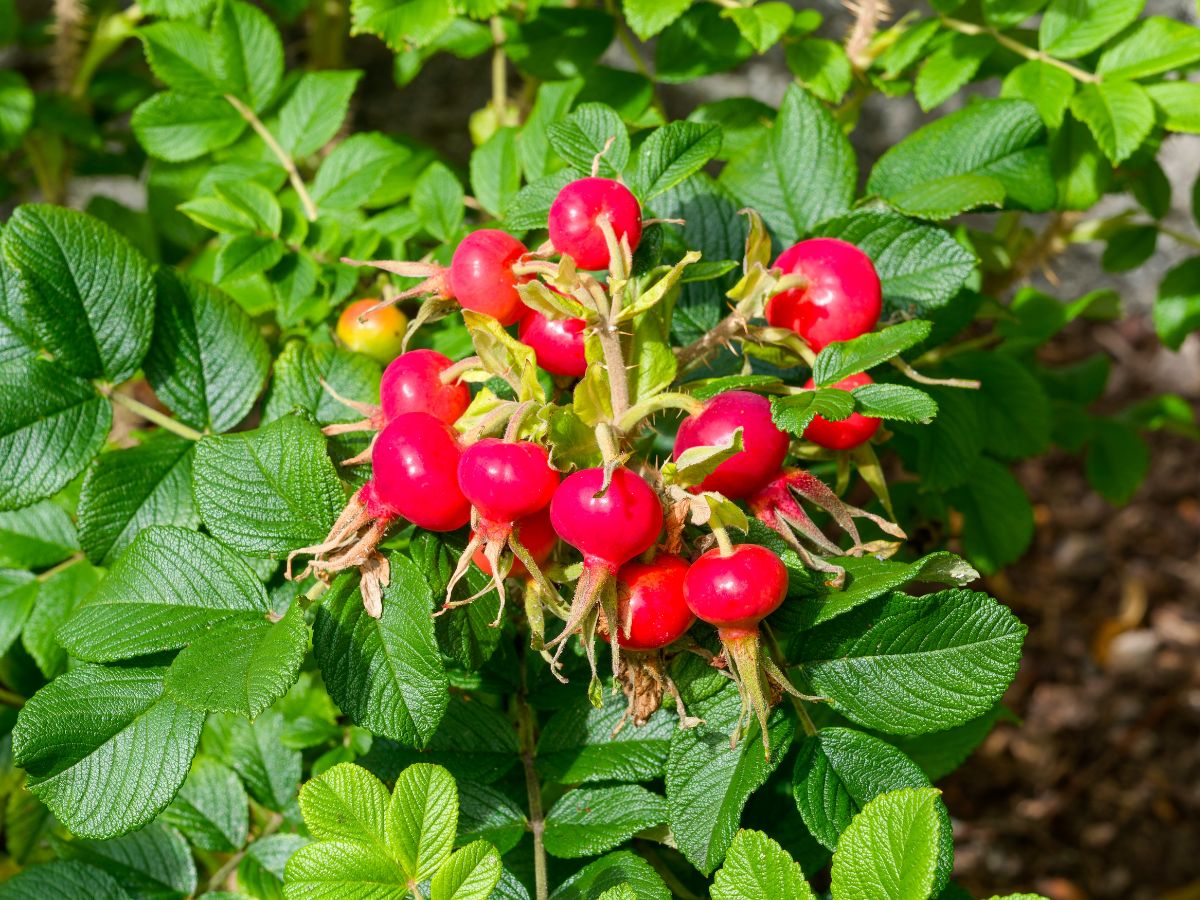
Gallica roses (Rosa gallica) – Also called apothecary rose, French rose, Rose de Provins, Champagne rose, and Gallic rose. This brilliant magenta rose was apparently brought to the Provins region of France during the Crusades. It was commonly grown in medieval gardens for its medicinal qualities – though its delicious, spicy fragrance may have also played a part in its value.
Its red hips are smaller and less generous than the flamboyant rugosa roses, but they’re still valuable.
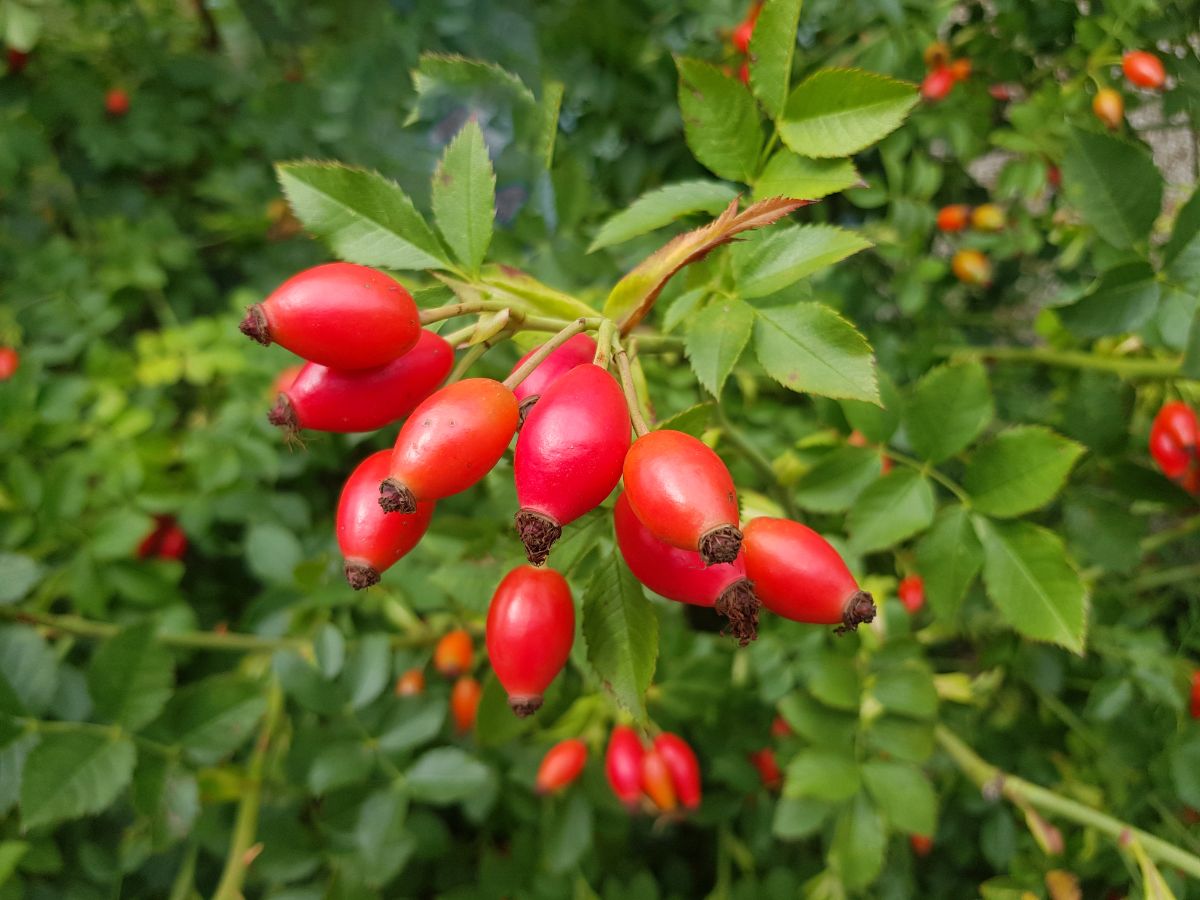
Dog roses (Rosa canina) – This is also called briar rose and dog briar. The small red hips from these roses have been used for medicinal products. Even back in the days of the Roman Empire, Pliny the Elder wrote about the root of the dog rose being used as an antidote for dog bites.
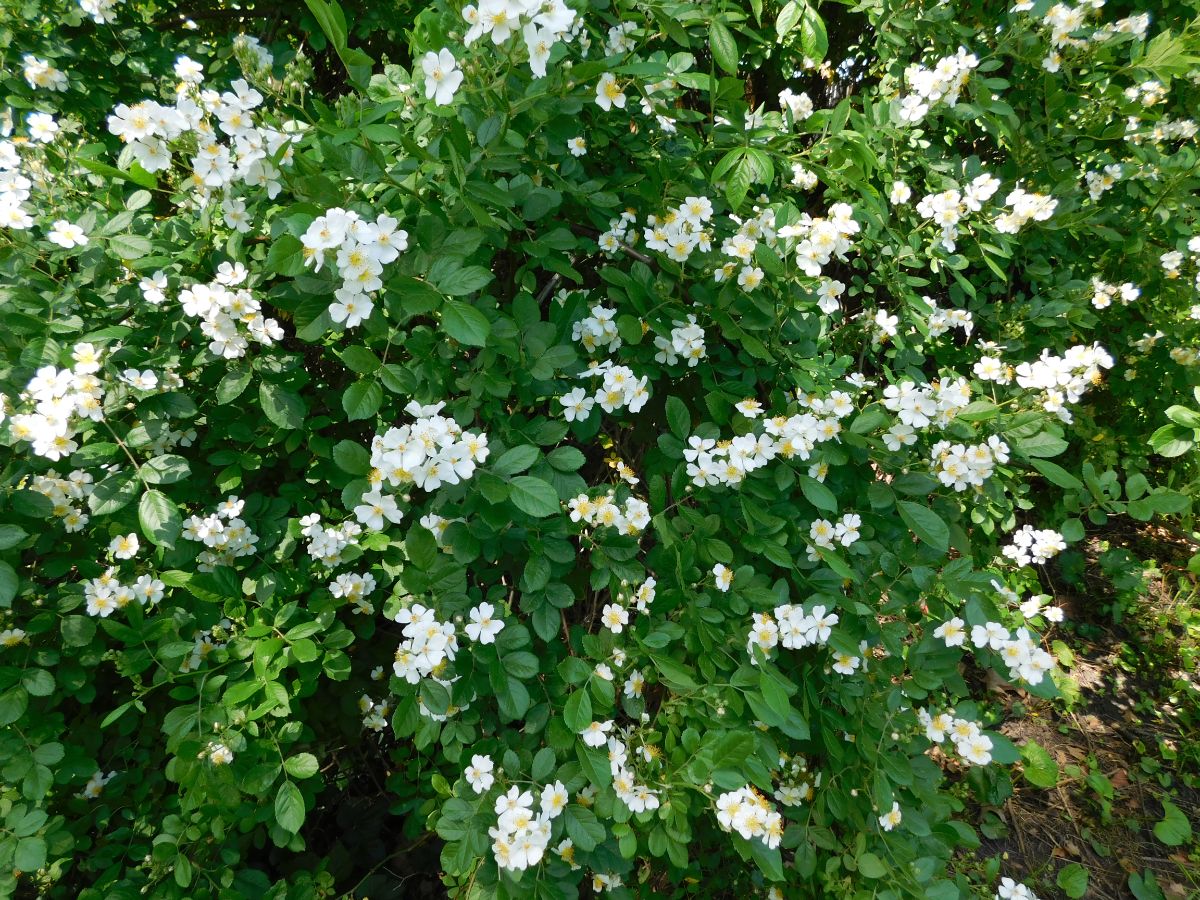
Multiflora rose (Rosa multiflora) – Multiflora rose was once a common rose that was grown along the highways in the United States. It was grown as erosion control and wildlife cover but ended up being very invasive because birds and animals would spread the seeds of the tasty hips far and wide.
However, the multiflora rose was beset by a deadly virus called rose rosette disease that killed off a lot of these roses, gradually spreading to garden roses along the way. Though its invasiveness is still an issue, its numbers have declined.
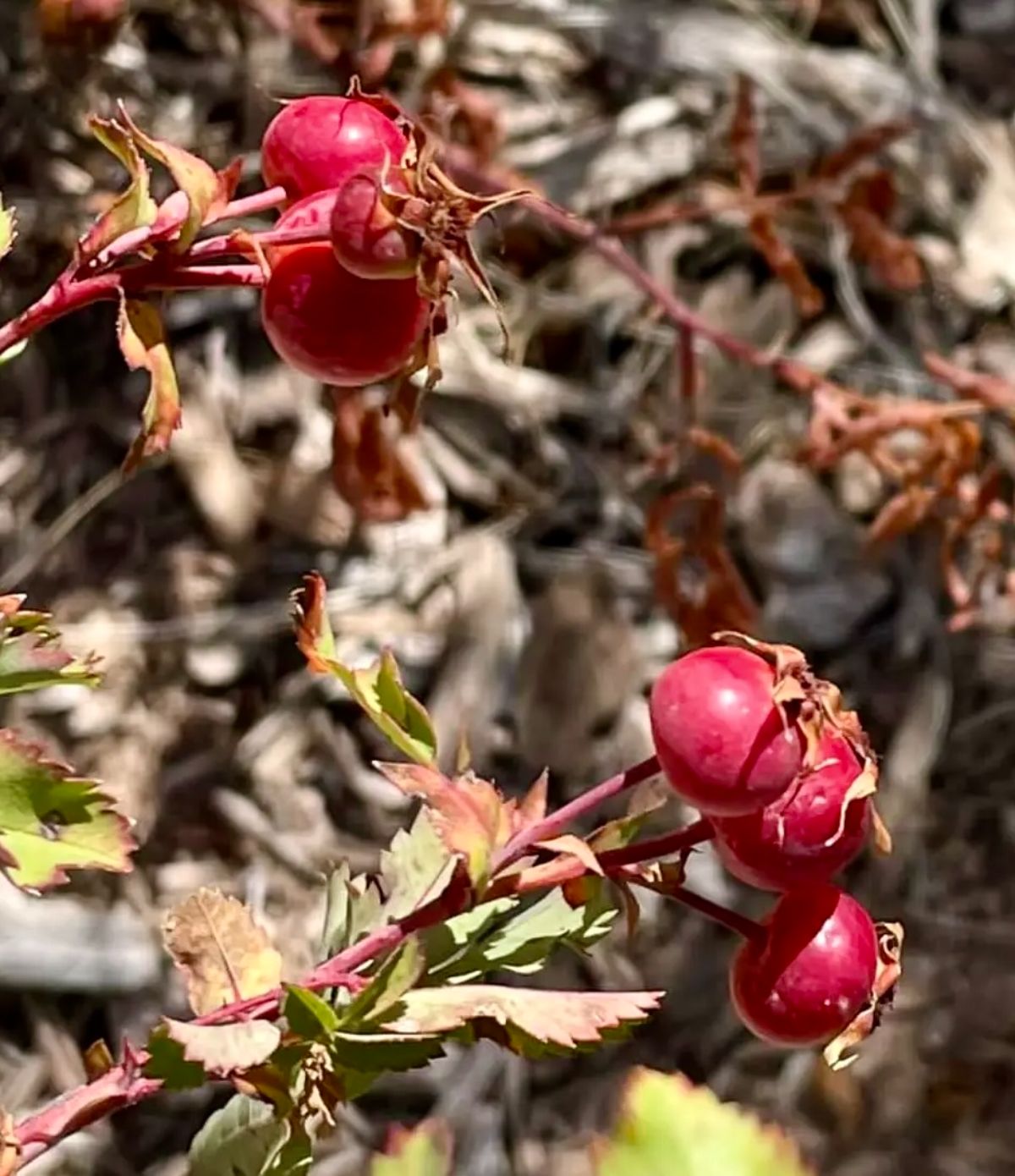
Prairie rose (Rosa arkansana) – A wild rose that grows across great swaths of the United States, the prairie rose has little pink (sometimes whitish-pink) flowers with five notched petals and golden stamens. These are followed by red hips in late summer and into fall.
Due to its deep roots, the plant is resistant to drought and fire – one of the few roses to flourish during the Dust Bowl and the Great Depression.
Modern roses – I have a ‘Penelope’ rose in my yard, which is a hybrid musk rose that was bred in 1924. When my son was little, he kept grabbing the dried old rose hips off the rosebush and putting them in his mouth. Finally, out of curiosity, I tried one. It tasted like apple-scented plywood.
You’ll usually see hips on big roses, such as shrub roses and climbing roses. They aren’t generally as showy as the old rugosa roses, but they’re still worthwhile.
When Can I Harvest Rose Hips?
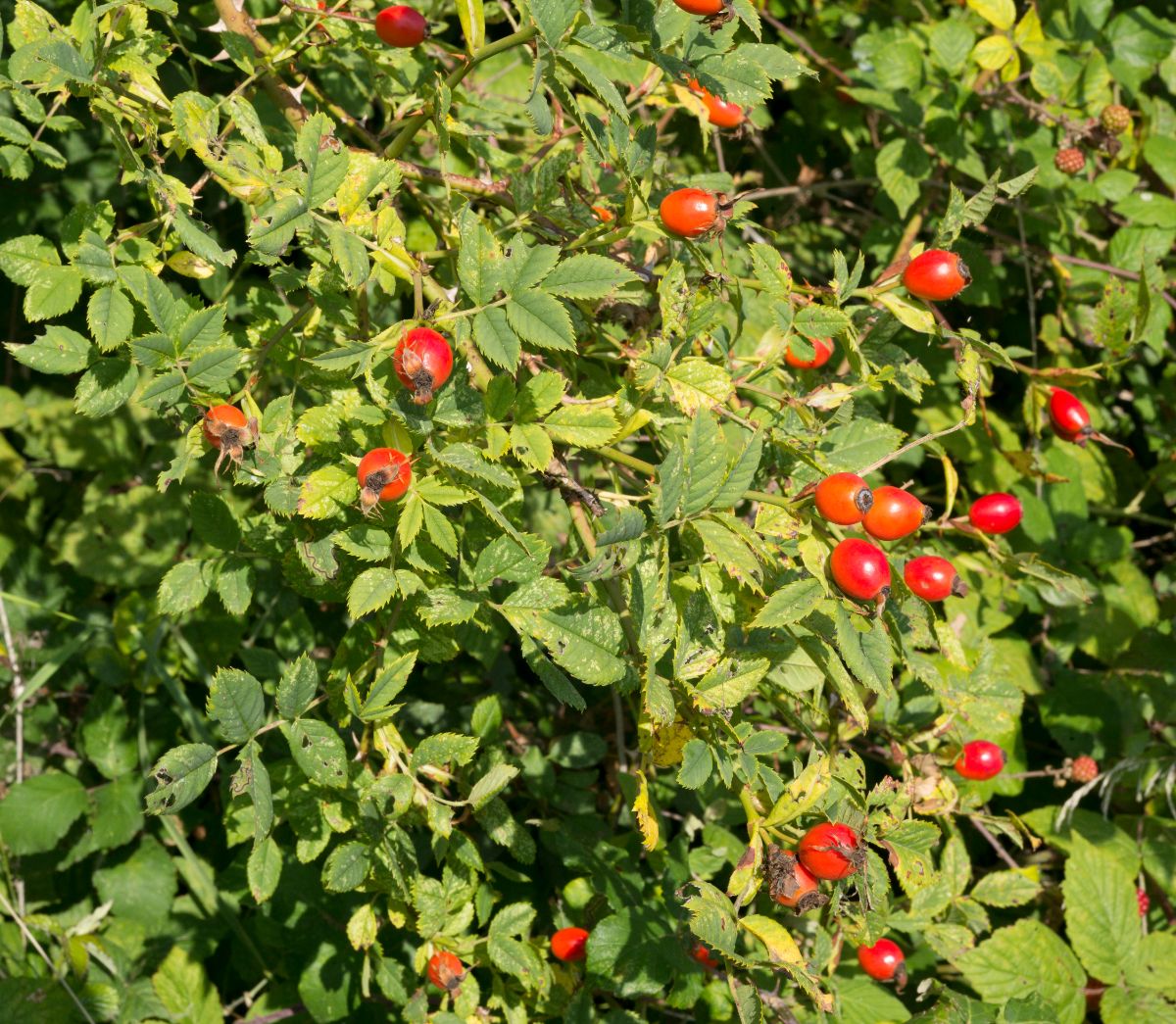
Some folks say to wait until after frost to harvest rose hips because the frost can bring out the sweetness. However, you can also harvest them any time after they turn bright red, orange, or yellow on the rose in summer. When you gently squeeze them, the hips should yield slightly, like a ripe apple.
Skip hips that are too soft or wrinkly. They’re overripe and won’t be as tasty.
Traditionally, rose hips have been harvested after frost because the freezing weather will bring out the sugar of the hips. But that was back in the days before freezers were invented! So you can harvest the rose hips any time, then bring your harvest home, put them in a resealable freezer bag, and tuck them in the freezer until you’re ready to use them.
How Do I Harvest Rose Hips?
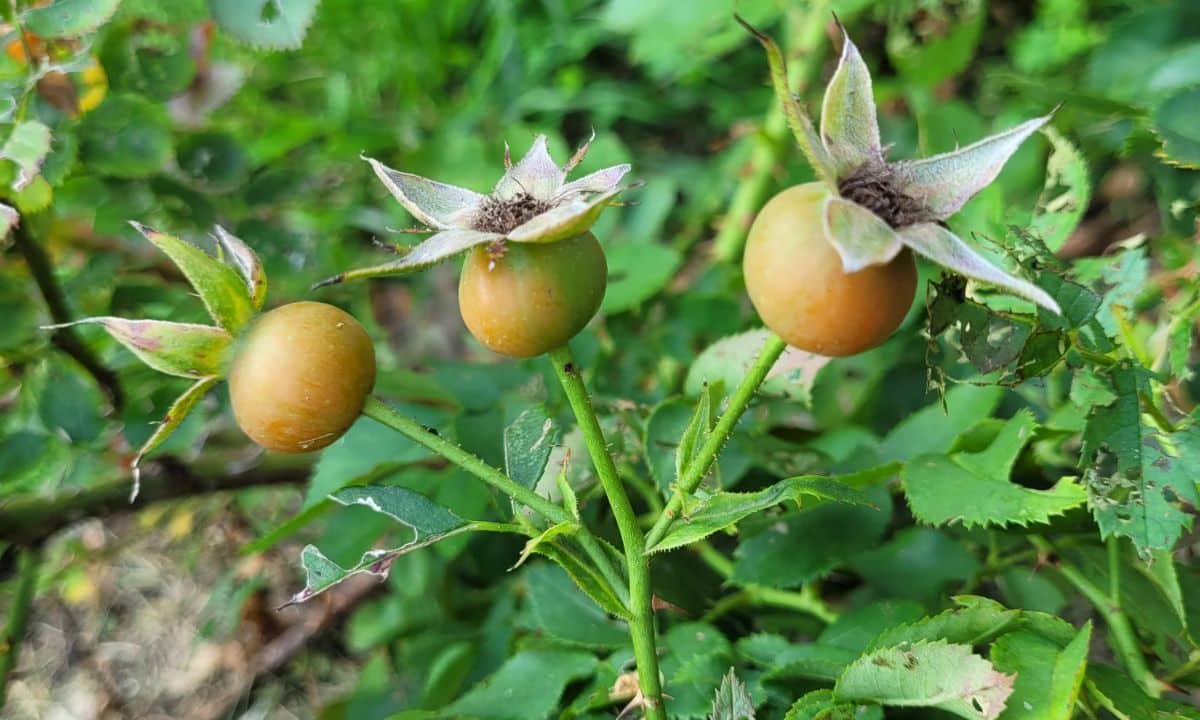
All right, foragers, assemble your equipment!
You'll need:
- Foraging bags for gathering a billion rose hips.
- Pruners for snipping, just in case a rose attacks you.
- Rose gauntlets. Regular gloves won’t do the trick. You need gauntlets to protect your forearms from the thorn-wielding roses.
- A long-sleeved shirt.
- Denim jeans, closed-toe shoes, and socks. If you live in tick country, tuck your jeans into your socks before venturing into the field. This will help keep the ticks off your legs.
- Duct tape if you have real concerns about ticks. Some no-nonsense biologists wrap duct tape around the jeans/socks intersection to keep out crawlers or seed ticks. (I live in tick country and am more concerned about ticks than thorns, personally.)
- Insect spray if you’re plagued by mosquitoes.
The nice thing about roses is that it’s generally hard to mistake them for anything else. They usually have thorns, and the leaves have five, seven, or three leaflets. Even if you get them mixed up with hawthorn berries or crabapples, there’s still no harm done, as these are edible as well (though maybe sour).
Look for red, orange, or yellow hips that easily separate from the stem when you tug on them. Don’t pick green hips – they won’t ripen.
Leave some rose hips for wild animals and birds. Don’t strip the roses of all their hips. You can go to a grocery store and get food, but they can’t.
Try sampling the rose hips while you’re picking them. They consist of a thin layer of fruit around a group of seeds. Nibble it or scrape the fruit part off with your front teeth. They’re often sour or tart, but sometimes you’ll find a rose that bears sweet hips. Just don’t bite into the seeds! Enjoy the good part, then toss the seeds back to the ground to grow more roses – or take them home and plant a hedge.
The rose hips are sweeter and less acidic after a frost, but once they’ve gone through a lot of freezes, they get soft and aren’t as tasty. All the same, if you see some rose hips in January, you can harvest them to make a tasty cup of tea.
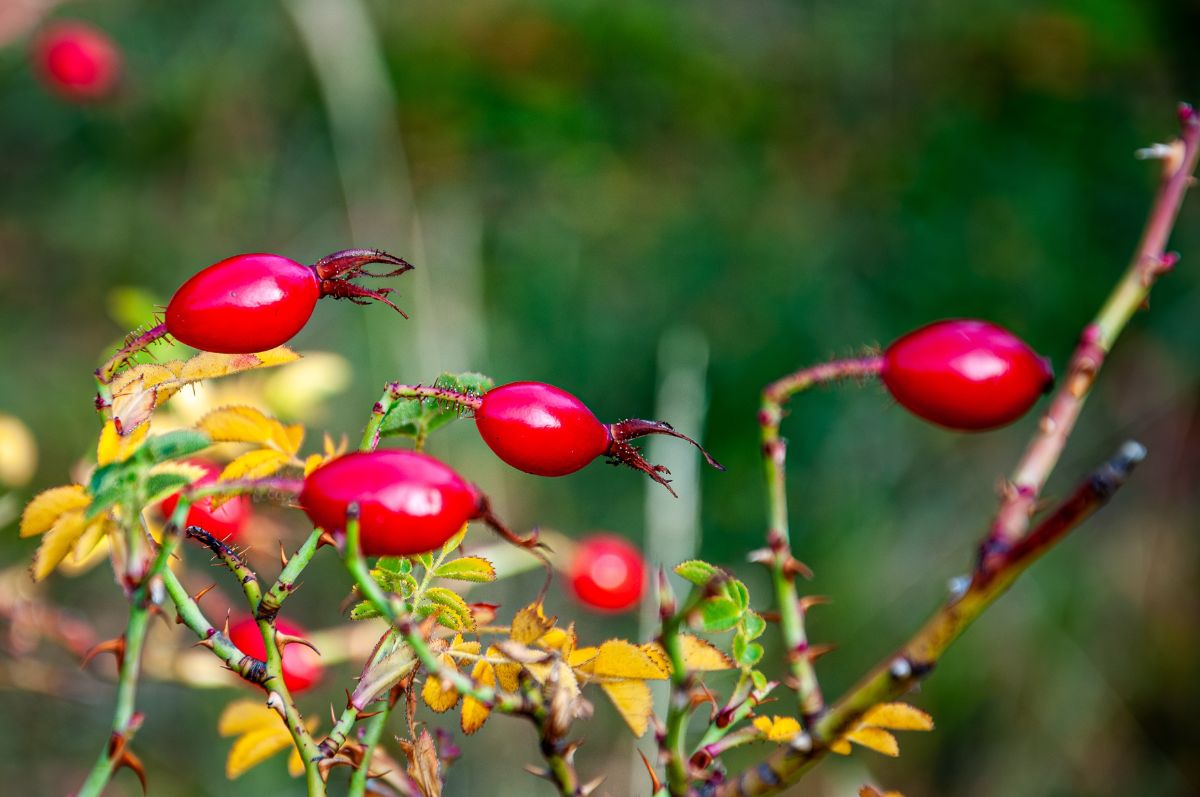
It’s a good idea to be a “safety first” kind of person, so keep these tips in mind when you go out foraging:
- Know what you’re picking. Sometimes roses and other plants will grow together, and other red berries can be mildly poisonous or cause intestinal distress.
- Skip roses that have been sprayed. For obvious reasons. Even if you wash your rose hips well, chemical residues can remain. A wild rose or even a garden rose that looks a bit ragged and has weeds growing around it, is probably fine.
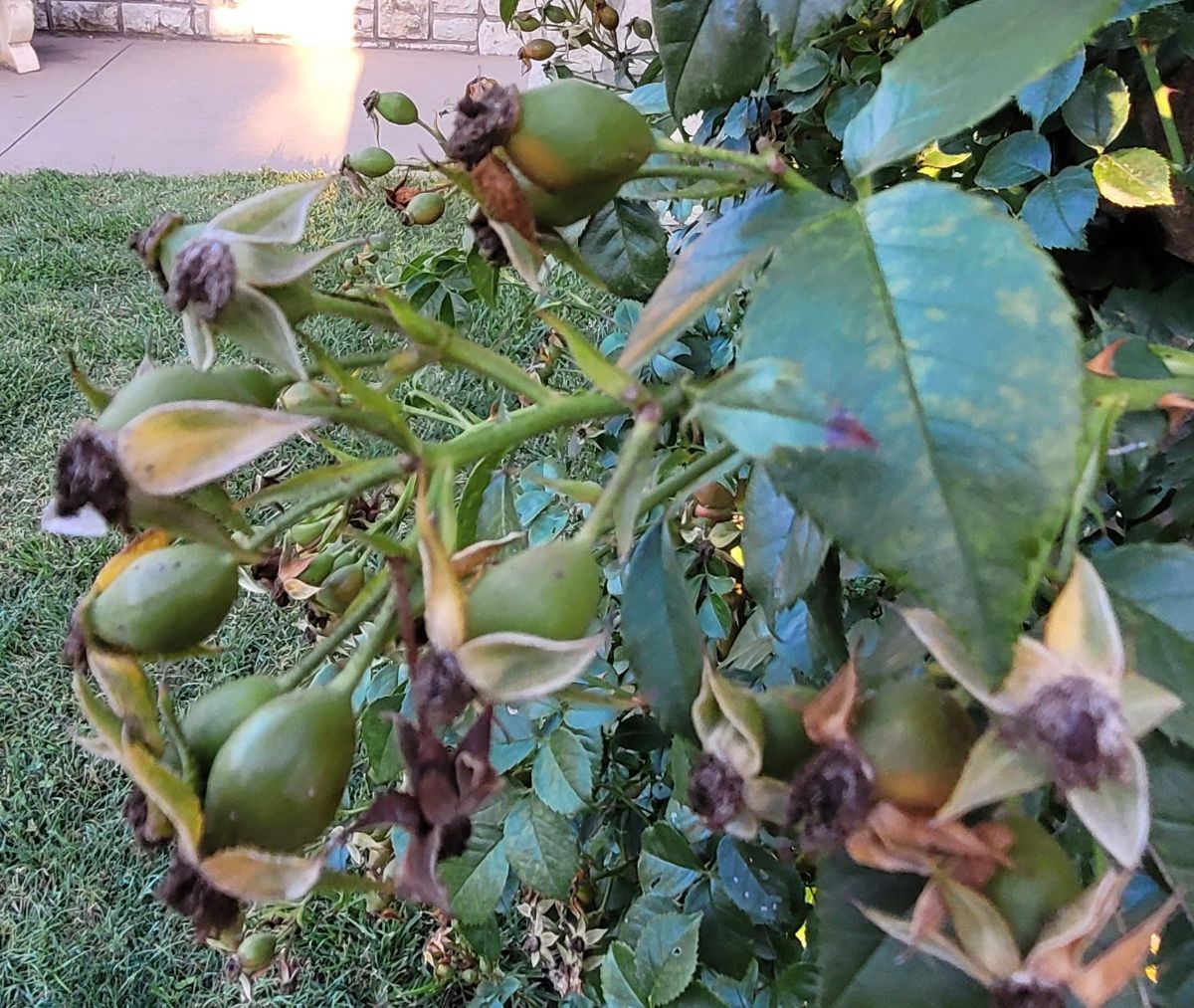
- Ask permission before harvesting. If the rose is in a neighbor’s yard or along the street, ask before you start picking off all the hips. It’s just a good-hearted thing to do, and sometimes they’ll tell you all about the rose.
- Watch out for thorns! Those roses will stab you if they get a chance. I’ve had to remove many tiny thorns from my fingers over the years. Call it an occupational hazard.
- Sometimes rose hips are hard to find. If this is your first year foraging, then you might have trouble finding good sources for hips! I live in the Great Plains area of the United States, where it’s dry and windy. Rugosa roses don’t care for this place. Many wild roses have been killed off by rose rosette disease, as well as farmers and other people who like clean, sterile fencerows and despise wild areas (though to be fair they are also trying to control invasive species). I have been looking all over for rose hips with no luck. So I’m planting my own antique roses. Next year is going to be better.
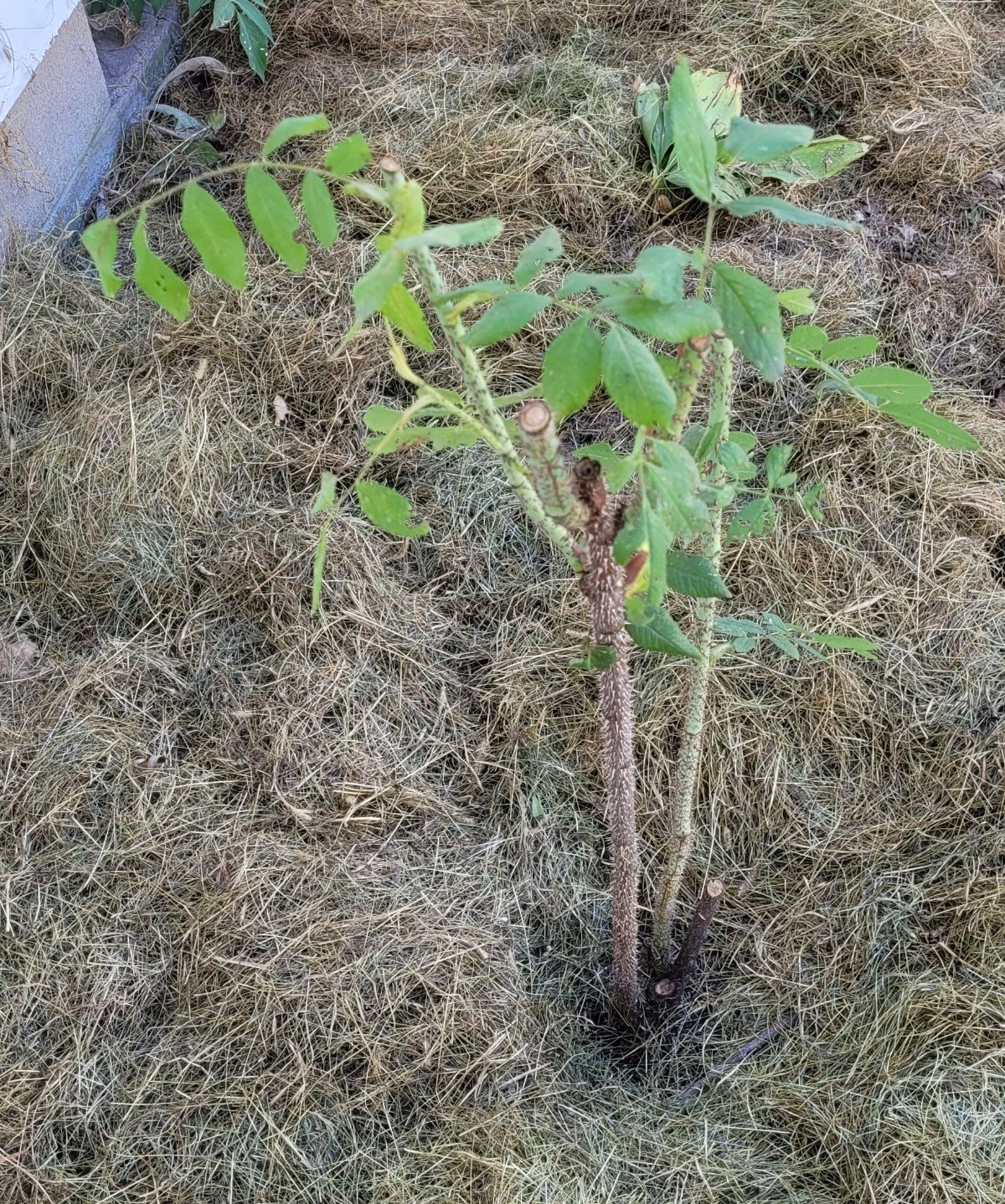
Cleaning Rose Hips (Be Sure to Wear Gloves)
Win-win: You’ve found 300 rose hips!
Win-lose: You have to clean 600 rose hip halves!
Cleaning rose hips can be tedious – and itchy, so be sure to listen to an audiobook or some good music to help the time move along.
Cut each hip in half and use a little spoon to scrape out the seeds and hairs, then wash them to get rid of the remaining seeds and hair.
The little hairs around the seeds are itchy, so be careful. Don’t touch your nose while you’re cleaning rose hips because your nose will itch for the rest of your life, pretty much.
It’s worse, though, if the hairs get stuck under your nails. They’ll hurt for days. Wear gloves.
…But You Don’t Have to Clean Rose Hips
If you aren’t using the hips for tea or bread, then you can skip cleaning the rose hips! Just pulse the hips through a food processor, or just cut them in half.
Throw the chopped hips into a pot of boiling water. Boil the rose hips for an hour until they’re soft.
Mash them, then strain them twice through cheesecloth or a tightly woven cloth to catch the irritating little seeds. Then use them in your recipes.
Freeze the Rose Hips Whole to Sweeten Them Up!

If you don’t have many rose hips ready to harvest, freezing your small harvests allows you to keep gathering hips until you have enough to process.
Freezing rose hips is a great way to activate their sugar content (which frost generally does in the wild), especially if you’re picking your rose hips through the late summer and fall.
To keep your rose hips from sticking together in the bag, lay them out on a baking sheet and put them in the freezer for three hours or more. After that, you can take them out and pour them straight into the freezer bag. This also works great with other berries, such as black raspberries and blueberries.
Rose hips are such excellent fruits – they’re good, and they’re good for you. Get outdoors and start searching for these cheerful wonders.


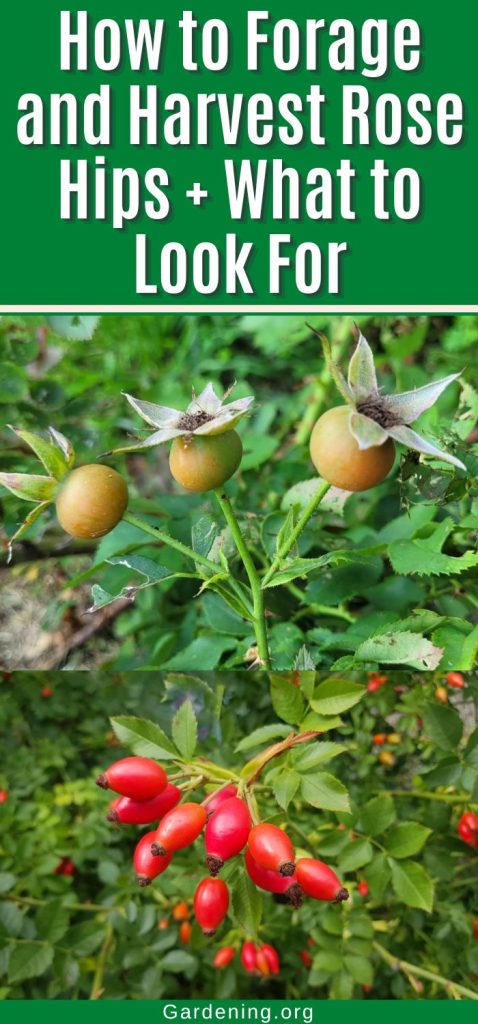






Leave a Reply